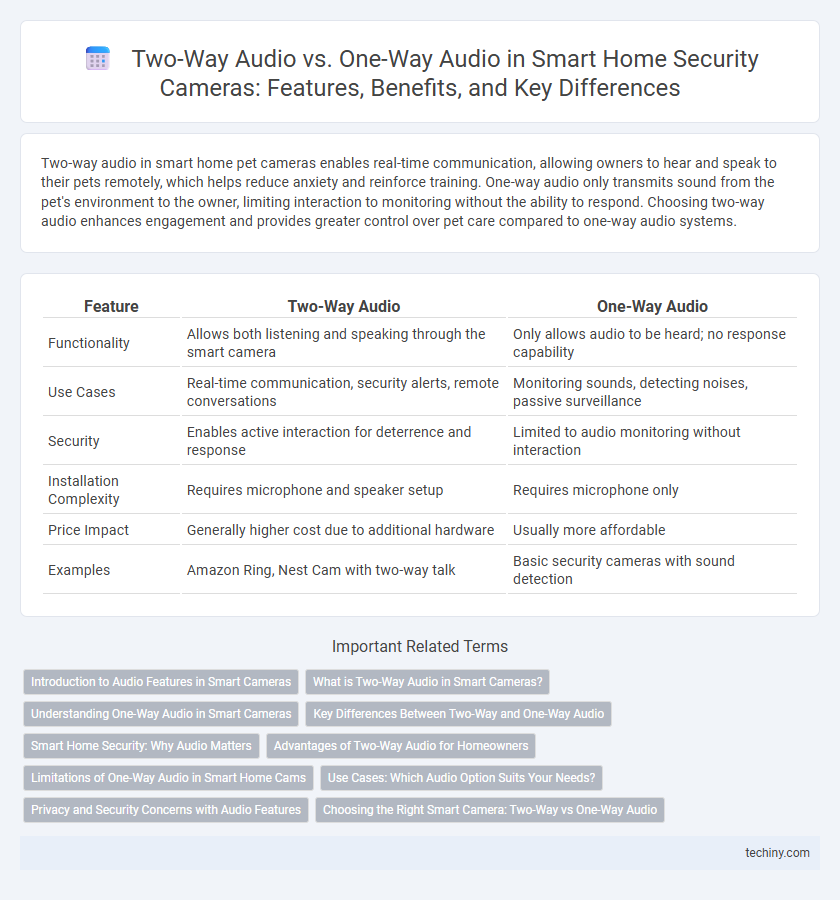Two-way audio in smart home pet cameras enables real-time communication, allowing owners to hear and speak to their pets remotely, which helps reduce anxiety and reinforce training. One-way audio only transmits sound from the pet's environment to the owner, limiting interaction to monitoring without the ability to respond. Choosing two-way audio enhances engagement and provides greater control over pet care compared to one-way audio systems.
Table of Comparison
| Feature | Two-Way Audio | One-Way Audio |
|---|---|---|
| Functionality | Allows both listening and speaking through the smart camera | Only allows audio to be heard; no response capability |
| Use Cases | Real-time communication, security alerts, remote conversations | Monitoring sounds, detecting noises, passive surveillance |
| Security | Enables active interaction for deterrence and response | Limited to audio monitoring without interaction |
| Installation Complexity | Requires microphone and speaker setup | Requires microphone only |
| Price Impact | Generally higher cost due to additional hardware | Usually more affordable |
| Examples | Amazon Ring, Nest Cam with two-way talk | Basic security cameras with sound detection |
Introduction to Audio Features in Smart Cameras
Smart cameras with two-way audio enable real-time communication by allowing users to both listen and speak through the device, enhancing security and interaction. In contrast, one-way audio supports only sound capture without microphone feedback, limiting user engagement to passive monitoring. The integration of two-way audio transforms smart cameras from simple surveillance tools into interactive devices for remote communication, making them essential for comprehensive smart home systems.
What is Two-Way Audio in Smart Cameras?
Two-way audio in smart cameras enables real-time communication by allowing users to both listen and speak through the camera using an integrated microphone and speaker. This feature enhances home security and convenience by enabling remote interaction with visitors, delivery personnel, or family members directly via a smartphone or other connected device. Unlike one-way audio, which only supports listening, two-way audio transforms a smart camera into an interactive communication tool.
Understanding One-Way Audio in Smart Cameras
One-way audio in smart cameras enables users to listen to audio from the camera's environment without the ability to speak or transmit sound back. This feature is commonly used for monitoring purposes, providing a clear audio feed to detect noises or conversations in the monitored area. One-way audio supports security and awareness but lacks interactive communication capabilities found in two-way audio systems.
Key Differences Between Two-Way and One-Way Audio
Two-way audio in smart cameras allows real-time communication between the user and visitors by enabling both listening and speaking capabilities, while one-way audio only supports sound monitoring from the camera to the user. Two-way audio enhances security and convenience by facilitating remote interactions, such as issuing warnings or greeting guests, whereas one-way audio limits functionality to passive audio surveillance. Choosing between the two depends on the desired level of interactivity and use case requirements in smart home security systems.
Smart Home Security: Why Audio Matters
Two-way audio in smart cameras enhances home security by enabling real-time communication between homeowners and visitors or potential intruders, providing immediate deterrence and response capabilities. Unlike one-way audio, which only allows the camera to capture sound, two-way audio allows users to listen and speak remotely, adding an interactive layer to security monitoring. This feature improves situational awareness and enables proactive engagement, critical for effective smart home security systems.
Advantages of Two-Way Audio for Homeowners
Two-way audio in smart cameras enables real-time communication between homeowners and visitors or intruders, enhancing security and convenience by allowing immediate interaction without physical presence. This feature supports effective remote monitoring, enabling users to issue warnings or instructions, deter potential intrusions, and provide responses to delivery personnel or family members. Compared to one-way audio, two-way audio significantly improves homeowner control and responsiveness, making smart home security systems more interactive and user-friendly.
Limitations of One-Way Audio in Smart Home Cams
One-way audio in smart home cameras restricts communication by allowing only sound to be heard from the camera to the user, limiting interactive capabilities essential for real-time responses. This limitation reduces security effectiveness, as users cannot verbally warn intruders or communicate with family members remotely. Without two-way audio, smart home systems miss critical engagement features that enhance user control and real-time interaction.
Use Cases: Which Audio Option Suits Your Needs?
Two-way audio smart cameras enable real-time communication, making them ideal for monitoring children, interacting with pets, or remotely instructing visitors. One-way audio systems primarily support passive listening scenarios such as surveillance and security monitoring, where capturing ambient sound without response is sufficient. Choosing between the two depends on whether interactive communication or simple audio monitoring best suits your smart home security requirements.
Privacy and Security Concerns with Audio Features
Two-way audio in smart cameras enhances interaction by enabling real-time communication but raises significant privacy concerns due to the potential for unauthorized listening or recording. One-way audio limits this risk by only allowing sound monitoring without enabling users to speak through the device, reducing vulnerabilities to hacking or eavesdropping. Security protocols such as end-to-end encryption and user authentication are critical in mitigating risks associated with audio features in smart home surveillance systems.
Choosing the Right Smart Camera: Two-Way vs One-Way Audio
Choosing the right smart camera involves evaluating the benefits of two-way audio versus one-way audio for home security and communication. Two-way audio enables real-time interaction, allowing homeowners to listen and speak through the camera, which enhances remote monitoring, deterrence of intruders, and convenience for communicating with family members or delivery personnel. One-way audio, typically limited to listening, may suffice for basic monitoring but lacks the interactive functionality necessary for proactive security and user engagement in smart home systems.
Two-Way Audio vs One-Way Audio (Smart Cameras) Infographic

 techiny.com
techiny.com